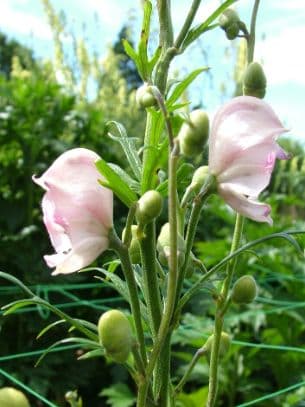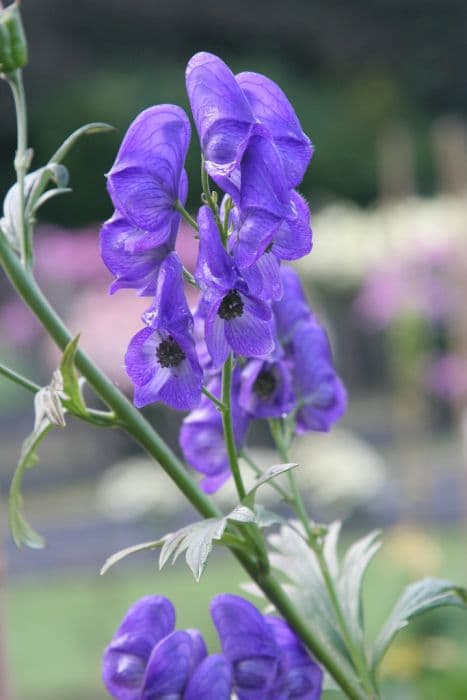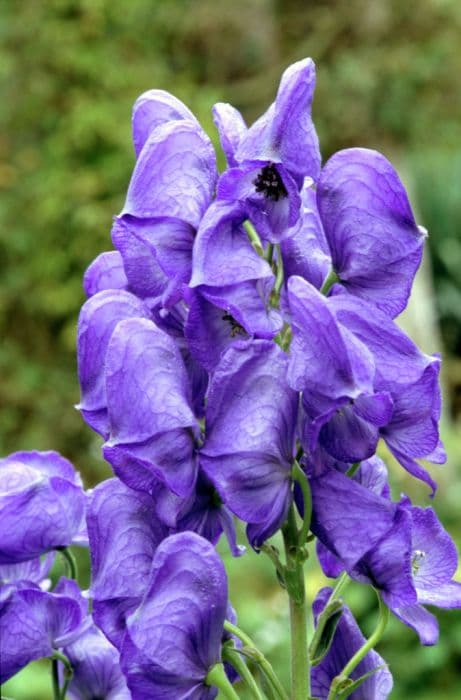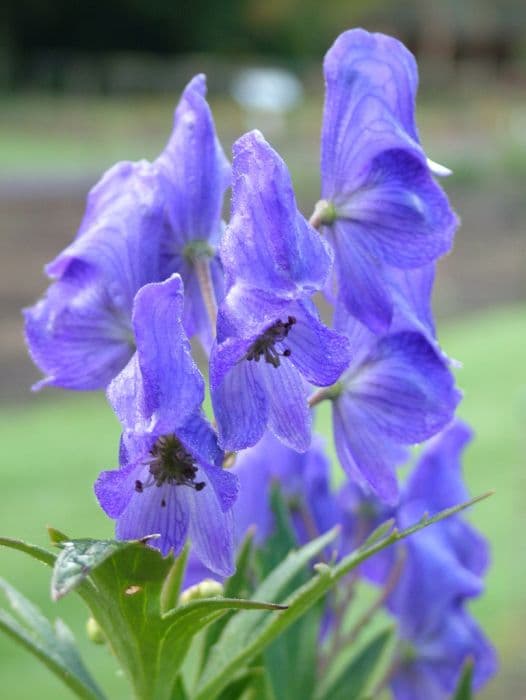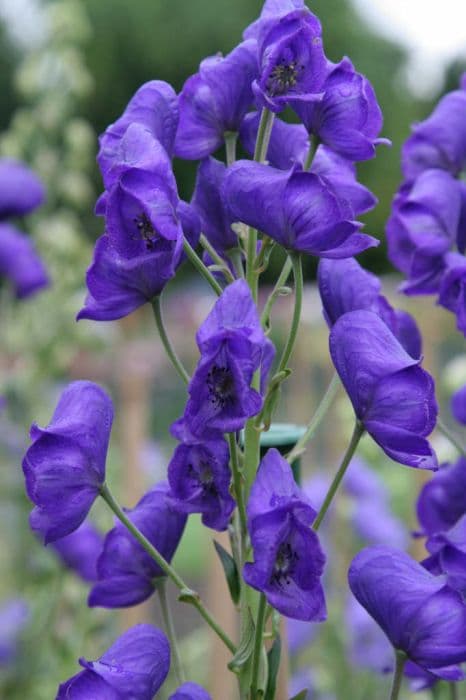Clematis Clematis 'Geoffrey Tolver' (LL)

ABOUT
Clematis 'Geffrey Tolver' is known for its stunning flowers, which are the most distinctive feature of this climbing vine. The blossoms are typically large and showy, boasting a vibrant color palette with shades that can range from a deep, rich purple to a lighter mauve. Each flower consists of several pointed petals, arranged in a star-shaped fashion that gives them a striking and elegant appearance. The center of the flowers often displays a contrasting array of stamens, which add to their ornamental value. The foliage of the Clematis 'Geoffrey Tolver' is also worth noting, with leaves that are green, lush, and sometimes possessing a glossy sheen. The leaves are compound, with each leaf composed of smaller leaflets, which add to the plant's textured look. As a climber, this clematis can be trained to grow along fences, trellises, or arbors, creating a vertical spectacle of color and greenery.
About this plant
 Names
NamesFamily
Ranunculaceae
Synonyms
Geoffrey Tolver Clematis
Common names
Clematis 'Geoffrey Tolver'
 Toxicity
ToxicityTo humans
The common name for Clematis 'Geoffrey Tolver' is clematis. Clematis plants are considered to be toxic to humans if ingested. The plant contains compounds known as glycosides, which can cause severe symptoms when consumed. The toxicity primarily affects the digestive system, leading to symptoms that may include nausea, vomiting, diarrhea, and salivation. In some cases, consuming clematis may also cause mouth irritation and ulcers. The skin can also be irritated by contact with the sap, causing dermatitis in sensitive individuals. It is important to handle clematis with care and to avoid ingesting any part of the plant to prevent these adverse reactions.
To pets
The common name for Clematis 'Geoffrey Tolver' is clematis. Clematis is toxic to pets if ingested. The toxic principle in clematis is irritating glycoside compounds. When a pet consumes parts of the clematis plant, it can experience symptoms such as excessive drooling, vomiting, and diarrhea. In some cases, ingestion can also lead to ataxia which is a loss of control of body movements. To ensure the safety of pets, it is advisable to prevent access to clematis and to seek immediate veterinary care if a pet is suspected of ingesting any part of this toxic plant.
 Characteristics
CharacteristicsLife cycle
Perennials
Foliage type
Deciduous
Color of leaves
Green
Flower color
Purple
Height
6-9 feet (1.8-2.7 meters)
Spread
3-4 feet (0.9-1.2 meters)
Plant type
Climber
Hardiness zones
4-9
Native area
Europe
Benefits
 General Benefits
General Benefits- Aesthetic Appeal: Adds visual interest to gardens with its vibrant and showy flowers.
- Vertical Interest: Can be trained to climb trellises, walls, and fences, utilizing vertical space in the garden.
- Seasonal Interest: Blooms mainly in late spring and early summer, providing seasonal color and variation.
- Attracts Wildlife: Invites beneficial pollinators such as bees and butterflies into the garden, helping to pollinate other plants.
- Privacy Screening: Offers a natural way to create privacy in the garden when grown on structures.
- Versatility: Can be grown in a variety of settings, including containers, making it suitable for both large gardens and small spaces.
- Easy Pruning: Typically requires minimal pruning, making it low maintenance in terms of upkeep.
- Diversity: Comes in a range of colors and forms, allowing gardeners to choose specific varieties that complement their garden design.
- Cold Hardy: Adapts well to a range of climatic conditions and can withstand cold temperatures once established.
- Long-Lived: With proper care, clematis plants can be very long-lived, providing beauty for many years.
 Medical Properties
Medical PropertiesThis plant is not used for medical purposes.
 Air-purifying Qualities
Air-purifying QualitiesThis plant is not specifically known for air purifying qualities.
 Other Uses
Other Uses- Clematis can be used in small space gardens, climbing up trellises or arbors to add vertical interest without taking up valuable ground space.
- The vine's woody structure provides winter interest in the garden even after the leaves have fallen.
- Dried clematis seed heads can be used in floral arrangements for unique texture and shape.
- Clematis can act as a natural screen or privacy barrier when grown on fences or lattice work.
- Some gardeners cultivate clematis vines to create living tunnels or archways in garden pathways.
- When planted near small trees or shrubs, clematis can use them as natural support structures, adding depth and layers to garden design.
- Clematis vines are sometimes used as a ground cover for large areas, where they spread out and suppress weeds.
- Gardeners can train young clematis plants to grow into unique and artistic forms with careful pruning and guidance.
- Clematis leaves can provide a lush backdrop in a cut flower arrangement, offering contrast to the blooming elements.
- Some species of clematis can be espaliered against a flat surface, turning a plain wall into a living piece of art.
Interesting Facts
 Feng Shui
Feng ShuiThe Clematis is not used in Feng Shui practice.
 Zodiac Sign Compitability
Zodiac Sign CompitabilityThe Clematis is not used in astrology practice.
 Plant Symbolism
Plant Symbolism- Ingenuity or Cleverness: Clematis varieties are known for their climbing ability, which symbolizes reaching for the sky or striving for higher achievements through intelligence and understanding.
- Mental Beauty: The intricate and diverse forms of Clematis blooms often represent the multifaceted nature of the intellect, highlighting mental beauty and agility.
- Artistic Inspiration: With its broad range of colours and forms, the Clematis plant is often seen as a muse for artists, embodying creative inspiration and the flourishing of ideas and artistry.
- Foresight: Clematis's growth pattern requires it to seek out and grow towards support structures, symbolizing the foresight needed to plan for the future and secure one's progress.
- Spiritual Pursuits: The climbing nature of Clematis also makes it a symbol for spiritual ascent, with its upward growth signifying a journey towards spiritual enlightenment or higher states of consciousness.
 Water
WaterClematis 'Geoffrey Tolver', commonly known as 'Jackmanii', should be watered thoroughly once a week with about one gallon of water, ensuring consistent moisture especially during the hot summer months. During the spring and fall, when temperatures are cooler and rain is more frequent, watering can often be reduced. It's important to aim the water directly to the base of the plant, avoiding overhead watering to prevent fungal diseases. The soil should be kept moist but not waterlogged. Adjust the watering frequency based on weather conditions, watering more during dry spells and less if there has been significant rainfall.
 Light
LightThe 'Jackmanii' Clematis prefers a location that receives full sun to partial shade, with at least six hours of sunlight a day being ideal. They thrive best when their foliage is in the sun while their roots are shaded, so consider planting low-growing shrubs or perennials around the base or mulching to keep the root zone cool.
 Temperature
Temperature'Jackmanii' Clematis does well in a range of temperatures, but they prefer being in an environment where the temperature is between 55 and 75 degrees Fahrenheit. They can survive winter temperatures down to around -20 degrees Fahrenheit but require appropriate care to ensure they survive the colder weather. During the growing season, maintaining an optimal temperature within this range will help promote vigorous growth and flowering.
 Pruning
Pruning'Jackmanii' Clematis blooms on new growth, so pruning is essential to encourage vigorous flowering. Prune the plant in late winter or early spring when buds show signs of growth, removing any dead or weak stems. Cut back the remaining stems to about 12 inches above ground level or to a pair of strong buds. This annual pruning encourages strong new growth and an abundance of blooms during the summer.
 Cleaning
CleaningAs needed
 Soil
SoilClematis, including the variety 'Geoffrey Tolver', thrives in well-draining soil with a neutral to slightly alkaline pH, between 7.0 and 7.5. The best soil mix can be created by combining two parts garden soil, one part compost or well-rotted manure, and one part gritty material like perlite or coarse sand for drainage. Add a handful of lime if soil is too acidic.
 Repotting
RepottingClematis 'Geoffrey Tolver' generally does not need frequent repotting as it is grown outdoors. If grown in a container, consider repotting every 2-3 years or when the plant outgrows its current pot, ensuring minimal disturbance to the roots.
 Humidity & Misting
Humidity & MistingClematis 'Geoffrey Tolver' prefers outdoor conditions where humidity is naturally regulated, but it does not require high humidity levels. Average outdoor humidity is sufficient for its growth, without the need for special humidity adjustments.
 Suitable locations
Suitable locationsIndoor
Ensure bright light, cool roots; use deep pot for indoor clematis growth.
Outdoor
Provide support and sunlight; protect roots with shade or mulch.
Hardiness zone
4-9 USDA
 Life cycle
Life cycleClematis 'Geoffrey Tolver' begins its life as a seed, which germinates when exposed to the right conditions of warmth and moisture, usually in spring or early summer. Once germinated, the seedling grows rapidly, developing a strong root system and a vine that starts to climb or sprawl, depending on available support. The plant enters a vegetative stage, where leaves mature and photosynthesis allows for vigorous growth. After reaching maturity, which can take a few years, Clematis 'Geoffrey Tolver' produces large, star-shaped flowers, typically in shades of pink or purple, during the warmer months. The flowers are followed by the production of seed heads, which dry and release seeds for dispersal. The plant then goes dormant in winter, with the cycle repeating annually as the plant emerges from dormancy in the spring.
 Propogation
PropogationPropogation time
Spring-Early Summer
Propogation: Clematis 'Geoffrey Tolver', commonly referred to as Clematis, is frequently propagated through semi-hardwood cuttings, which is the most popular method among gardeners. The optimal time for taking cuttings is during the summer when the current year's growth has started to mature but is not yet fully hardened. To propagate, select a healthy shoot and cut a 4 to 6-inch (10 to 15 cm) section just below a node using a clean, sharp tool. Remove the lower leaves and dip the cut end into a rooting hormone to encourage root development. Then, plant the cutting in a well-draining soil mixture, ensuring that at least one node is buried where leaves were removed, as this is where roots will form. After insertion, water the cutting and place it in a warm spot with indirect light, covering with a plastic bag to retain moisture. Roots typically develop within a few weeks, after which the new Clematis can eventually be transplanted outdoors.

